A potential explanation
The Basque Anomoly left questions which were difficult to answer. Did the Celts advance into Europe from the Atlantic coast, or did the Atlantic Celts have ancestors in Eastern Europe? Why do the Basques speak a non Indo Euopean language?
The suggestion is that there is an explanation. it starts whih the suggestion that at the end of the Ice Age fugitives from what I have called Indiantis arrived in Egypt.
R1 to R1b in Egypt
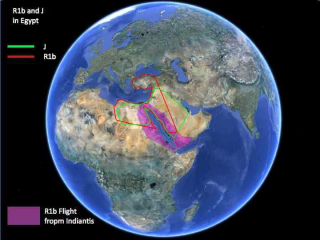 Ancient Egypt was not confined to the Nile valley and estuary. Right from the beginning they possessed land on the shores of the Red Sea, On the islands in the Red Sea and even on the Arabian Mainland. The nile valley was occupied mainly by Haplagroup J and group R1 did not displace them. They mutated to become R1b and became the rulers of Egypt assuming the status of Gods. They then went on to colonise much of the Eastern Mediterranean.
Ancient Egypt was not confined to the Nile valley and estuary. Right from the beginning they possessed land on the shores of the Red Sea, On the islands in the Red Sea and even on the Arabian Mainland. The nile valley was occupied mainly by Haplagroup J and group R1 did not displace them. They mutated to become R1b and became the rulers of Egypt assuming the status of Gods. They then went on to colonise much of the Eastern Mediterranean.If this speculation is correct there is no surprise that Tutankhamun’s DNA is R1b.
How did this gene get to the Pyrenees? As time passed the mutations continued, perhaps faster than in any other Haplogroup.
Anatolia
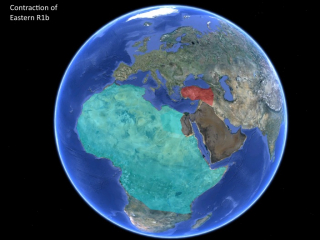 There were many influences afoot. Long before the Persian or Roman invasions it appears that the R1b Haplogroup, which typified the Egyptian rulers, concentrated in Anatolia.
There were many influences afoot. Long before the Persian or Roman invasions it appears that the R1b Haplogroup, which typified the Egyptian rulers, concentrated in Anatolia.
The J haplagroup,now judged to be a marker of the semitic races, remained dominent in Egypt itself whilst further west amongst the increasingly arid landscapes Haplogroup M, specifically African, became increasingly dominant.
Now we can return to the original speculation with a little more confidence.
R1b became R1b1 became R1b1a and by the time of Tutankhamun R1b1a2.
We must assume that up to this time the Egyptian influence on the rest of their empire was continually replenished from Egypt itself but from this further mutations R1b1a2a, R1b1a2a1a and R1b1a2a1a1 (L11) could have happened in Egypt in the Eastern Mediterranean or in the Pyrrenees.
The Migrations
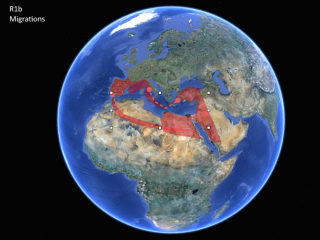
This diagram shows potential land migrations. There were also two well documented but admittedly legendary migrations both of which involved sea voyages.
Aeneus, the founder of Rome is reputed to have been a Trojan, driven out by the invading Greeks (see Research Topics/History/Roman Empire/Rise of Rome/Origins).
Brutus, founder of the British nation is also reputed to have been a refugee from Troy and perhaps significantly his legend allows him to pass through the Pyrenees(see Research Topics/Pseudo History/The Gallic Empire/The Conquest/Gallic Influences/Brutus)
The Berber Gene
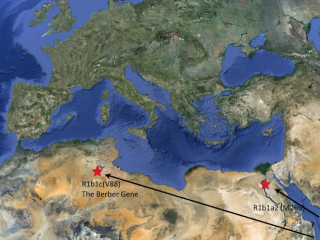 It is now known that the so called Berber Gene, tagged as V88, full name R1b1c is an dependent clone , quite separate from the Tutankhamun Gene,tagged as M269, full name R1b1a2. Closely related but different. Thus even though the previous diagram shows an alternative migration route through North Africa, that the Berber gene could not possibly mutate into L11, S116, AMH or M259.
It is now known that the so called Berber Gene, tagged as V88, full name R1b1c is an dependent clone , quite separate from the Tutankhamun Gene,tagged as M269, full name R1b1a2. Closely related but different. Thus even though the previous diagram shows an alternative migration route through North Africa, that the Berber gene could not possibly mutate into L11, S116, AMH or M259.
Different Mutations
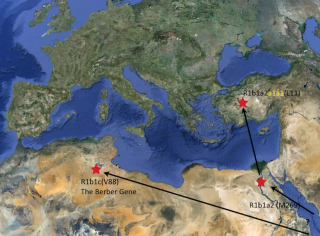 What we do know is that a mutation of the Tutankhamun Gene, tagged L11, Full name R1b1a2a1a1 did appear in Anatolia. Anatolia is close to the Caucusus but is also where Troy was located!
What we do know is that a mutation of the Tutankhamun Gene, tagged L11, Full name R1b1a2a1a1 did appear in Anatolia. Anatolia is close to the Caucusus but is also where Troy was located!
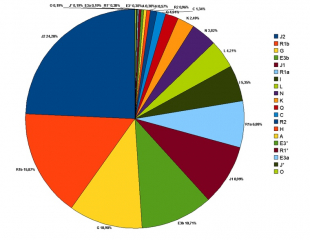 R1 mutations are a large percentage of the overall Turkish DNA Distribution. This is perhaps surprising considering the waves of Turkic invaders who have taken control of the country at various times. it is the reason we know that the migration we are tracing did pass through Anatolia and perhaps through Troy.
R1 mutations are a large percentage of the overall Turkish DNA Distribution. This is perhaps surprising considering the waves of Turkic invaders who have taken control of the country at various times. it is the reason we know that the migration we are tracing did pass through Anatolia and perhaps through Troy.
The Brutus legend certainly is supportive of a subsequent migration through the basque region, but what about the Aeneid?
Italy
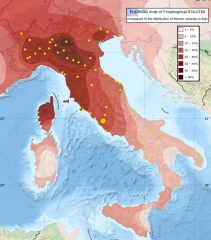 This took me completely by surprise. The first time I wrote this segment I ended up glossing over the fact that there was no evidence to support the Aeneid.
This took me completely by surprise. The first time I wrote this segment I ended up glossing over the fact that there was no evidence to support the Aeneid.
This diagram shows that is in fact a large R1 prescence in Italy and that there is a very good co-relation with Roman settlements. The fact that the greatest presence of R1 is in Milan does not surprise me. Just as the centre of the Eastern Empire was moved away from Rome to Byzantium, the centre of the western empire was for a substantial period moved to Milan
Two Celtic Nations
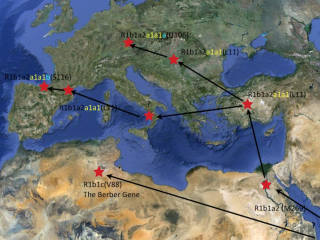 All that is absolutely certain is that a breeding stock of L11 arrived in the Pyrenees mutating to S116 in what is now Southern France and Northern Spain.
All that is absolutely certain is that a breeding stock of L11 arrived in the Pyrenees mutating to S116 in what is now Southern France and Northern Spain.
Interestingly the genetic record is that a second migration resulted in L11 travelling up the valley of the danube reaching the Halstatt region, mutating to U106.
The tags or shortnames make the differences seem more significant than the actually are. The Halstatt Celts are R1ba2a1a1a and the basques are Riba2a1a1b.
Three Celtic Nations
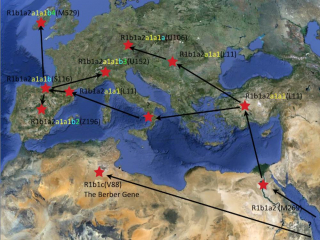 From the Basque country the migration continued north to Ireland,becoming M529, and south to Spain and western North Africa. It is possible,no probable thatthese peoples carried a non Indo_European language with them from Haplagroup K in the far east, through the islands of Indiantis, on to Egypt, Anatolia until reaching the Basque country. Incredible?-yes. Impossible?-no.
From the Basque country the migration continued north to Ireland,becoming M529, and south to Spain and western North Africa. It is possible,no probable thatthese peoples carried a non Indo_European language with them from Haplagroup K in the far east, through the islands of Indiantis, on to Egypt, Anatolia until reaching the Basque country. Incredible?-yes. Impossible?-no.
At the same time a mutation of the S116 Gene tagged U152 reached Northern Italy. there seems to be consensus that as shown in this diagram that this mutation occurred on the atlantic seaboard and the migrated back to northern Italy. there is however a tantalising alternative.
That the S116 mutation occurred in Troy and was carried to Italy and The Pyrenees by Aeneas and Brutus? Then the mutation to U152 could have occurred within the early Roman Empire. The diagram of the distribution of R1 in Italy would tend to support this. May be after all the Romans were just another Celtic Tribe!
Atlantic Modal Haplotype
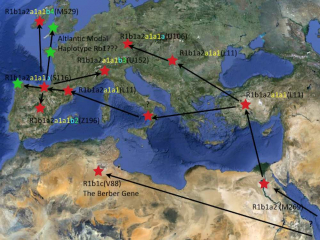 The mutations to The Atlantic Modal Haplotype along the Atlantic Seaboard was quite a separate event. In fact in terms of the most recent genealogical conventions the whole concept of the Modal Haplagroup is flawed.
The mutations to The Atlantic Modal Haplotype along the Atlantic Seaboard was quite a separate event. In fact in terms of the most recent genealogical conventions the whole concept of the Modal Haplagroup is flawed.
The Modal grouping is in fact occasioned by an earlier inability to recognise and identify sub-clades. What it really means is that for this grouping the incidence of mutations is vey high but it is known that many of them fall under the Atlantic Modal Group The concept was fine but it is rapidly being outmoded by modern DNA techniques.
However, there is also a consideration that it in this geographical area that the maximum interest in genealogical studies is focussed. It may well be as interest develops in other geographical areas, that there is an equivalent rate of mutations is occurring.
A darker side
As the Ice retreated, and the tree line and the animals targeted by hunters moved north, the humans followed. There were three separate movements Which have been identified. The R1b subclades expanded from the Pyreneees through what is now France along the Atlantic coast to Brittany and the British Islands.
There was a second later movement north from Spain directly to Ireland. Finally there was a movement from Anatolia along the Danube valley as far as the current boundary between Switzerland and Southern Germany. It was this latter group which displaced Haplogroup I from the Danube valley effectively splitting it in two, a split which can still be seen today.
It was this group of R1b which was known to the Greeks as “Keltoi” and though closely related they were not from the same mutation as in the the Pyrenees, Spain and the British isles.
Thus there were two separate groups of “celts” with the interface along the line of the Rhine River. Thus the assumption made about the spread of R1b to the atlantic seaboard is not contradicted by this more detailed analysis, though there are still many questions to be answered, not the least of which is why there is no residual R1b in Egypt.
That is possibly because in Egypt, the R1b was totally concentrated in the immediate royal family.
Expansion Of R1b
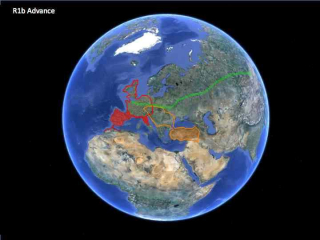 The net result of this was that western Europe became dominated by two different mutations of R1b. The difference between the two was significant and would continue until it was a major cause of disruption during the tenure of the Roman Empire.
The net result of this was that western Europe became dominated by two different mutations of R1b. The difference between the two was significant and would continue until it was a major cause of disruption during the tenure of the Roman Empire.
Expansion Of R1a
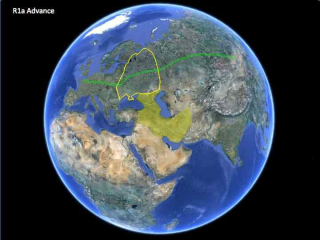 The expansion of R1a from a base in mesopotamia to Middle and Eastern Europe is totally confirmed by the genetic tests in the countries concerned.
The expansion of R1a from a base in mesopotamia to Middle and Eastern Europe is totally confirmed by the genetic tests in the countries concerned.
Expansion Of I
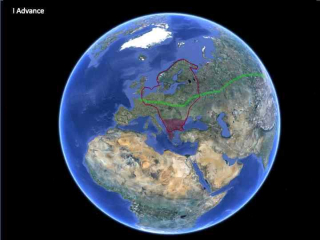 The Expansion of I into the northern reaches of europe is also confirmed even to the point where the intrusion of R1b along the Danube and R1a through the Ukraine and Belarus can be clearly seen.
The Expansion of I into the northern reaches of europe is also confirmed even to the point where the intrusion of R1b along the Danube and R1a through the Ukraine and Belarus can be clearly seen.
Expansion Of N
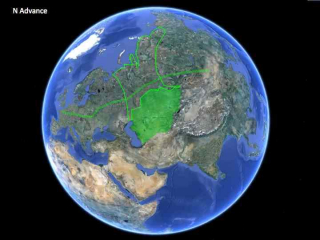 The northern fringes of Europe have become the preserve of those carrying the N haplogroup.
The northern fringes of Europe have become the preserve of those carrying the N haplogroup.
Antagonism
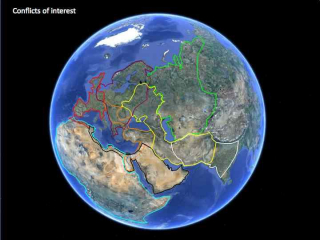 Drawing all this together shows that there is a certain order but also many overlaps. The areas of overlap and potential overlap have not been marked but sadly they mark the places where conflict has occurred time and time again. Human genetic mutation may be interesting but it is no cause for celebration. It would appear that humans are aware of genetic differences and use them as a cause for antagonism.
Drawing all this together shows that there is a certain order but also many overlaps. The areas of overlap and potential overlap have not been marked but sadly they mark the places where conflict has occurred time and time again. Human genetic mutation may be interesting but it is no cause for celebration. It would appear that humans are aware of genetic differences and use them as a cause for antagonism.
